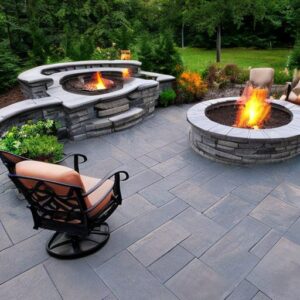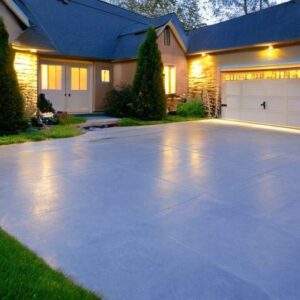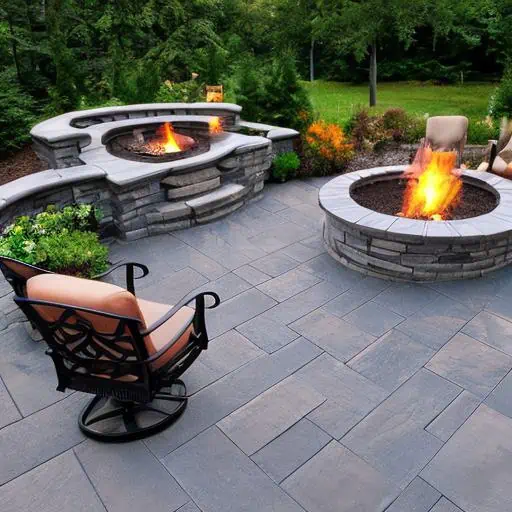
Stamped concrete is the best way to create a beautiful, long-lasting outdoor space. Compared to other hardscaping options, stamped concrete is more affordable, durable and customizable, making it the ideal choice for any outdoor area.
What is Better Than Stamped Concrete?
The popularity of stamped concrete has grown in recent years, but there are still many homeowners who want to know what is better than decorative concrete and the right type of material for their project. In this article, we’ll compare several types of alternatives to poured concrete so you can decide which one is best for your home or business. But nothing beats decorative concrete when it comes to how long it lasts and how durable it is, as well as how easy it is to install and keep up.
The more expensive top-of-the-line models, brick pavers, can have a psi strength of 8000, while stamped concrete and regular concrete have a psi strength of 5000. But the concrete is all one piece and has steel rebar installed. Pavers are individual pieces, which makes them not as strong as concrete, and they are more expensive. Concrete patios are also easier to install than the other alternatives because they’re just poured in place and finished with a trowel and rubber molds. With pavers, you have to lay them out and install each one individually, which can be time-consuming depending on how large your project is.
Alternatives To Stamped Concrete:
If you’re looking for something different than decorative concrete, there are a few alternatives. Here are some options:
- Flagstone
- Brick Pavers
- Regular concrete
- Exposed aggregate
Pros And Cons: Of Alternatives To Stamped Concrete
People often use interlocking concrete pavers and stamped concrete or paver pavement for patio flooring. But each has different advantages and disadvantages that should be taken into account when deciding which one is best for a given project. Even though both stamped concrete vs. brick paver patios has their own benefits, it’s important to give both a lot of thought before deciding which one would be best for a certain outdoor pool deck space. When making this choice, you should think about how you want it to look, how much it will cost, how long it will last, and how easy it will be to set up so that all of your needs are met in an efficient and effective way.
Pros and Cons: of Alternatives to Stamped Concrete vs Pavers
Pros:
- Can be repaired easily by replacing individual pieces.
- Pavers offer a large selection of colors.
- Large selection of designs.
- They can increase home value.
Cons:
- It’s not as durable as decorative concrete, so it may need to be replaced sooner than expected if you live in an area with harsh weather conditions or heavy traffic.
- Constant maintenance ( picking weeds and grass – weekly maintenance.)
- Individual pavers need to be replaced by an installer every 1 to 2 years in damaged areas.
- Does not withstand heavy commercial vehicle use.
- Extremely expensive compared to colored textured concrete.
- have to pay someone to come out and repair and replace the polymeric sand control joints every 2 years.
- Water gets in between the pavers and causes shifting in the ground which results in the pavers coming apart.

Costs: Of Alternatives To Stamped Concrete:
Stamped concrete and interlocking concrete pavers are great options for many homeowners, but they’re not the only ones. Depending on what you want to achieve, there are other alternatives that may be more suitable for your needs and budget.
Cost of Alternatives to Textured Concrete vs. Alternatives
- Stamped Concrete $16 per sq ft (average $16/sq ft)
- Regular Concrete is $12 per sq ft (average $12/sq ft)
- Exposed Aggregate $28 per sq ft (average $28/sqft)
- Brick Paver Patios $25 per sq ft (average $25/sq ft)
- Flagstone $30 per sq ft (average $30/sq ft)
Cost of Stamped Concrete vs. Alternatives:
- Stamped Concrete = $16 vs Brick Pavers = $25
- Stamped Concrete = $16 vs Flag-Stone = $30
- Stamped Concrete = $16 vs Exposed Aggregate = $28
- Stamped Concrete = $16 vs Regular Concrete = $12
Homeowners often compare different decorative options before making a decision, leading to discussions about flagstone vs stamped concrete prices, as both can enhance the aesthetic appeal of a property. Ultimately, the choice will depend on personal preference, budget, and maintenance considerations.
Installation: Of Alternatives To Comparison of Stamped Concrete
Colored imprinted concrete stains are like traditional concrete when it comes to installation. It needs a 6-inch base with 2 inches of crushed stone and 4 inches of concrete. The forms and steel rebar are then installed. A concrete driveway is put in place and troweled, and then rubber molds are used to imprint the concrete with a release powder. The following day, strip forms, cut expansion joints, and pressure wash. Then apply 2 coats of solvent-based sealer.
- Flagstone – Requires the ground to be dug out 1 foot and hard-pack and crushed stone to be installed. Stone requires heavy machinery to bring the stone to the property and for placement. Requires professional masons to cut and place the stones together to give the desired results.
- Brick Pavers – Needs 2 forms of fill to be brought in to pave, including hard-pack sand and crushed rock. Needs a base of 1 foot for preparation. Requires heavy machinery to be on the property to place the large concrete paving pallets of patio pavers on the driveway. No skill is needed, these can be installed by homeowners and can be installed by putting each piece together and using a concrete saw with a diamond blade to cut the pavers into place.
- Regular Concrete – Needs 6 inches of the base, 2 inches of crushed stone, and 4 inches of concrete. Steel rebar needs to be laid down in 4ft sections after the forming has been done. Then the concrete is brought over in a wheelbarrow and placed where required. Then the concrete is trowel finished and expansion joints are tooled into the surface. Next-day forms are removed.
- Exposed Aggregate – Same as regular concrete, needs a 6-inch base. 2 inches of crushed stone, and 4 inches of concrete. Requires a large crew of skilled helpers and needs colored stones brought to the property. The concrete is brought over in wheelbarrows and the slab is poured out. Then the colored stone is broadcasted out onto the surface and troweled in. The next phase is, spraying the surface with a retarder that is pressure washed off the next day with the top layer of the cement, which exposes the stone. The last step is to pull the forms, cut expansion joints, then pressure wash and seal with 2 coats of clear coat.
Maintenance: Of Alternatives To Stamped Concrete
Every 3–5 years, concrete stamping needs to be resealed, and once a year, it should be pressure washed.
- Flag-Stone – Needs mortared joints to be replaced regularly, at least every 2 years. Pressure washed once a year.
- Brick Pavers – Requires weekly maintenance which involves removing weeds and grass. On top of that, needs polymeric sand to be replaced every 1 to 2 years to fix existing grout joints from cracking from bricks moving from the ground shifting and rain (water) getting in between the bricks. Besides all the expensive maintenance issues involved, it should be pressure washed once a year.
- Regular Concrete – No sealing required, just needs to be pressure washed once a year.
- Exposed Aggregate – Needs to be resealed every 3 to 5 years and should be pressure washed once a year.

Color Options: For Alternatives To Stamped Concrete
Textured colored concrete has a large selection of colors and patterns for patios.
- Flag-stone – Limited in colors and designs. It’s a natural stone pave which is limited.
- Brick Pavers – Large selection of interlocking pavers colors and patterns.
- Regular concrete – No color and no designs, usually a broom finish.
- Exposed aggregate – Usually a contractor will have at least 12 different colors to choose from.
Durability: Of Alternatives To Stamped Concrete
Colored concrete has a lifespan of 25 years! extremely durable and cost-effective, although stamped concrete has some disadvantages.
- Flag-stone – 10 to 20-year lifespan.
- Brick Pavers – 10 to 20-year lifespan.
- Regular Concrete Products – 25-year lifespan.
- Exposed aggregate – 25-year lifespan.
When deciding on a better choice for pavers vs. stamped concrete patios, driveways, and walkways, it’s essential to think about all of your options. We hope this article has helped you make an informed decision about your next project!
Our Locations:
Nashua, NH
North Hampton, NH
Concord, NH

